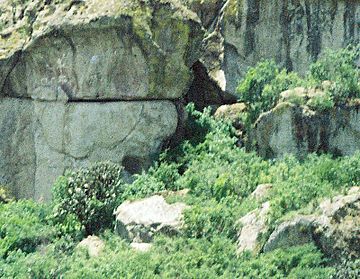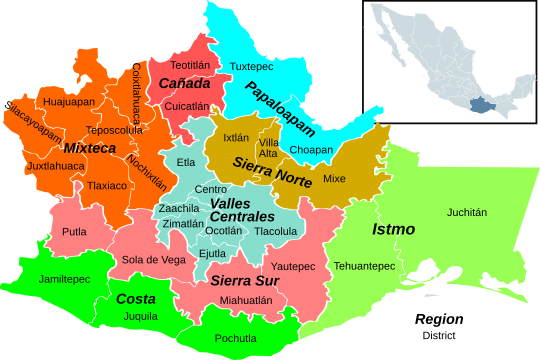Oaxaca Valley facts for kids
The Central Valleys (also called Valles Centrales in Spanish) of Oaxaca are a special area in southern Mexico. This region is shaped a bit like a "Y" that's upside down. Each arm of the "Y" has its own name: the Etla arm in the northwest, the Valle Grande in the south, and the Tlacolula arm to the east.
This valley was once home to the Zapotec civilization, one of the first complex societies in Mesoamerica. Later, the Mixtec people also lived here. You can find many important ancient sites in the Oaxaca Valley, like Monte Albán, Mitla, San José Mogote, and Yagul. Today, Oaxaca City, the capital of the state, is located right in the middle of this valley.
Contents
A Look at History
The Zapotec people were very powerful in the valley and the surrounding highlands for a long time, from early ancient times until the end of the Classic period. After them, the Mixtec culture became important.
Early Times: The Formative Period
| UNESCO World Heritage Site | |
|---|---|

|
|
| Location | Oaxaca, Mexico |
| Criteria | Cultural: (iii) |
| Inscription | 2010 (34th Session) |
| Area | 1,515.17 ha (3,744.1 acres) |
| Buffer zone | 3,859.74 ha (9,537.6 acres) |
One of the first settlements in the Oaxaca Valley was San José Mogote. It was in the Etla arm of the valley. At first, it was a farming village. Over time, people there started to have different social levels. Some people were born into important positions, rather than earning them.
People in the valley during this time also connected with the Olmec culture, which was very advanced. We are still learning how much the Olmecs influenced the Zapotec civilization.
Besides San José Mogote, there were other important centers in the valley. These included Tilcajete in the Valle Grande and Yegüih in the Tlacolula arm. For a while, the population was spread out among these three places. People likely traded and shared ideas, as their pottery and art styles were similar.
Later, during the Late Formative period, big changes happened. Many people moved to a new place that had been empty before: Monte Albán. By 400 BC, this site, built on top of a flattened mountain, had about 5,200 people. Even though it didn't have easy access to water, its population quickly grew to about 17,200 within 200 years. This made it one of the largest cities in Mesoamerica at the time.
As Monte Albán grew, the other major centers like San José Mogote, Tilcajete, and Yegüih were quickly left empty. This fast shift of people to one new central place is sometimes called the "Monte Albán Synoikism." Monte Albán became the main center for government and power in the Oaxaca Valley. It grew into a powerful state, expanding its influence to other areas.
The Classic Period
During the Early Classic period (around AD 200-650), Monte Albán was the heart of the Zapotec state. The Zapotec people also interacted with other powerful cities, especially Teotihuacan. Art and carvings at Monte Albán show visitors from Teotihuacan. There's even evidence that a Zapotec neighborhood existed in Teotihuacan.
Monte Albán stayed important until the end of the Early Classic period. Its power seemed to lessen as Teotihuacan's power declined. Other centers, which had once been part of the Zapotec state, started to become independent. These included Cuilpan and Zaachila in the Valle Grande, and Lambityeco and Mitla in the Tlacolula arm. By about AD 900, Monte Albán, the former capital, was abandoned.
Later Times: The Postclassic Period
During the Postclassic period (roughly AD 1000–1520), Zapotec people still lived in the Oaxaca Valley. However, the area often came under the control of the Mixtec state, which was located to the west. One important Mixtec center was Mitla, in the eastern Tlacolula arm.
After the Aztecs defeated the Mixtec, the Zapotec people were also conquered by the Aztec emperor Ahuitzotl between 1497 and 1502. However, the Mixtecs and Zapotecs worked together and were able to survive. The Oaxaca Valley then became part of the Aztec Empire.
The Colonial Period
The Aztec empire ended when the Spanish conquered their capital, Tenochtitlan, in August 1521. A few months later, in November 1521, a Spanish explorer named Francisco de Oruzco arrived in the Oaxaca Valley. He claimed the land for the Spanish leader Hernán Cortés. Cortés was given Oaxaca as a reward for conquering New Spain, and he was named Marques del Valle de Oaxaca.
In 1521, the Spanish started a community called Segura de la Frontera. It was in the central part of the Oaxaca Valley, about 9 kilometers (5.6 miles) east of Monte Albán. This community was later called Nueva Antequera. In 1532, Emperor Charles V officially made it a "royal" city, naming it Antequera de Guaxaca. Today, it is known as Oaxaca or Oaxaca City.
After settling, the Spanish quickly brought new crops and farming methods to the Oaxaca Valley. For example, Cortés ordered people to grow wheat in the Etla arm and build mills to grind it.
See also



